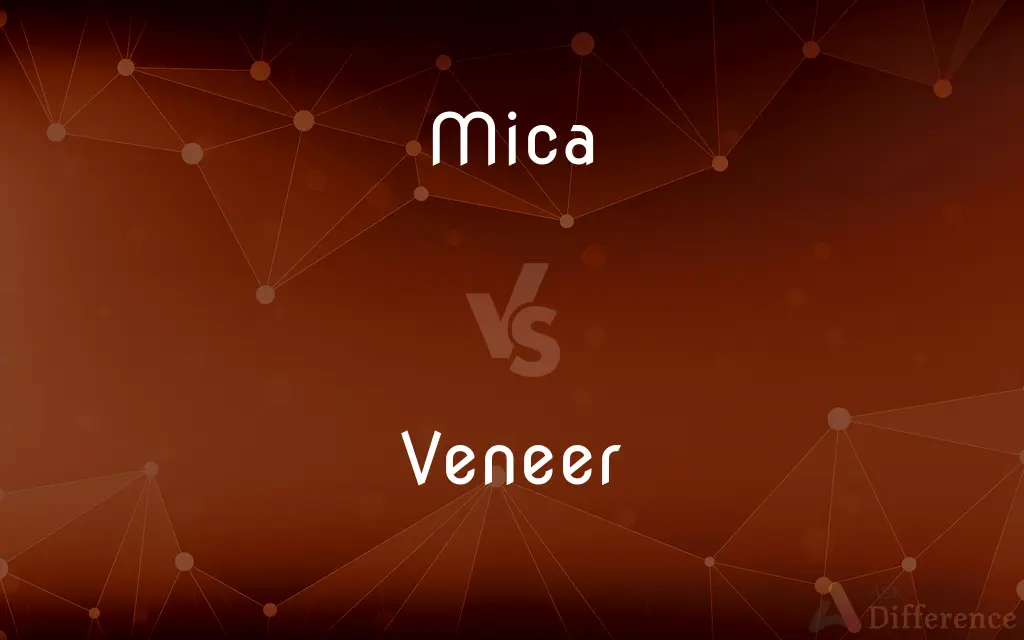Mica vs. Veneer — What's the Difference?
By Tayyaba Rehman — Updated on September 28, 2023
Mica is a naturally occurring mineral used for its insulating properties, while veneer is a thin decorative layer applied to surfaces.

Difference Between Mica and Veneer
Table of Contents
ADVERTISEMENT
Key Differences
Mica is a silicate mineral known for its distinct sheet-like structure, which gives it an easily separable, layered form. These unique properties make mica highly sought after in various industries, especially for electrical insulation and cosmetics. Veneer, on the other hand, refers to a thin layer or sheet of material, often wood, that is adhered to another surface to improve its appearance. It's commonly utilized in furniture, cabinetry, and interior design.
The utilization of mica dates back centuries. Its ability to resist electricity and heat while maintaining transparency makes it invaluable in specific applications, like electronics and as windows in stove and heater doors. Comparatively, veneer is a hallmark of high-quality woodworking, offering an affordable way to achieve the appearance of expensive or rare woods on more common materials.
While mica is prized for its functional attributes in industries, its use in cosmetics, especially eyeshadows and foundations, is due to its shimmering, light-reflecting qualities. Veneer, meanwhile, serves mainly aesthetic purposes. By employing veneers, craftsmen can create exquisite furniture pieces without using solid slabs of often scarce and expensive woods.
It's essential to differentiate between the two: mica, being a mineral, is excavated from the earth, whereas veneer is typically manufactured by slicing fine sheets from logs or by creating reconstituted versions from wood pulp and resin. Both have their distinct realms of application and are indispensable in their respective industries.
Comparison Chart
Nature
Mineral
Thin decorative layer
ADVERTISEMENT
Primary Use
Insulation, cosmetics
Aesthetics in woodworking
Composition
Silicate mineral
Often wood, but can be other materials
Extraction/Production
Mined
Manufactured, sliced from logs
Main Application Area
Electricals, cosmetics
Furniture, cabinetry
Compare with Definitions
Mica
Transparent mineral
The mica window in the old heater allowed one to see the flames.
Veneer
Thin decorative layer
The table had a rich mahogany veneer.
Mica
Layered silicate mineral
Mica is often found in igneous rocks.
Veneer
Surface enhancement
Using a veneer can transform the appearance of basic furniture.
Mica
Heat-resistant mineral
Mica is used in industries requiring heat-resistant components.
Veneer
Cover for imperfections
A veneer can be used to hide damaged or unappealing surfaces.
Mica
Electrical insulator
Mica sheets are used in electronics due to their insulating properties.
Veneer
Layer adhered to another material
The veneer was carefully glued to the particleboard substrate.
Mica
Cosmetic ingredient
The eyeshadow's shimmer comes from finely-ground mica.
Veneer
A thin surface layer, as of finely grained wood, glued to a base of inferior material.
Mica
Micas ( MY-kəz) are a group of minerals whose outstanding physical characteristic is that individual mica crystals can easily be split into extremely thin elastic plates. This characteristic is described as perfect basal cleavage.
Veneer
Any of the thin layers glued together to make plywood.
Mica
A shiny silicate mineral with a layered structure, found as minute scales in granite and other rocks, or as crystals. It is used as a thermal or electrical insulator.
Veneer
A decorative facing, as of brick.
Mica
Any of a group of chemically and physically related aluminum silicate minerals, common in igneous and metamorphic rocks, characteristically splitting into flexible sheets used in insulation and electrical equipment.
Veneer
A deceptive, superficial show; a façade
A veneer of friendliness.
Mica
(mineral) Any of a group of hydrous aluminosilicate minerals characterized by highly perfect cleavage, so that they readily separate into very thin leaves, more or less elastic.
Veneer
To overlay (a surface) with a thin layer of a fine or decorative material.
Mica
The name of a group of minerals characterized by highly perfect cleavage, so that they readily separate into very thin leaves, more or less elastic. They differ widely in composition, and vary in color from pale brown or yellow to green or black. The transparent forms are used in lanterns, the doors of stoves, etc., being popularly called isinglass. Formerly called also cat-silver, and glimmer.
Veneer
To glue together (layers of wood) to make plywood.
Mica
Any of various minerals consisting of hydrous silicates of aluminum or potassium etc. that crystallize in forms that allow perfect cleavage into very thin leaves; used as dielectrics because of their resistance to electricity
Veneer
To conceal, as something common or crude, with a deceptively attractive outward show.
Veneer
A thin decorative covering of fine material (usually wood) applied to coarser wood or other material.
Veneer
An attractive appearance that covers or disguises one's true nature or feelings.
Veneer
To apply veneer to.
To veneer a piece of furniture with mahogany
Veneer
To disguise with apparent goodness.
Veneer
To overlay or plate with a thin layer of wood or other material for outer finish or decoration; as, to veneer a piece of furniture with mahogany. Used also figuratively.
As a rogue in grainVeneered with sanctimonious theory.
Veneer
A thin leaf or layer of a more valuable or beautiful material for overlaying an inferior one, especially such a thin leaf of wood to be glued to a cheaper wood; hence, external show; gloss; false pretense.
Veneer
Coating consisting of a thin layer of superior wood glued to a base of inferior wood
Veneer
An ornamental coating to a building
Veneer
Cover with veneer;
Veneer the furniture to protect it
Veneer
Woodworking technique
Craftsmen use veneers to achieve high-end looks without excessive costs.
Common Curiosities
Can mica be used in cosmetics?
Yes, mica is frequently used in cosmetics for its shimmering qualities.
Why is mica used in electrical appliances?
Mica's insulating properties make it valuable in preventing electrical conductance.
Are veneers exclusive to wood?
No, while wood is common, veneers can also be made of plastic, stone, or metal.
Is mica always transparent?
While many mica types are transparent, some can be opaque or colored.
How is veneer attached to surfaces?
Veneers are typically adhered using glues or adhesives.
Share Your Discovery

Previous Comparison
Apprentice vs. Novice
Next Comparison
Copper vs. RussetAuthor Spotlight
Written by
Tayyaba RehmanTayyaba Rehman is a distinguished writer, currently serving as a primary contributor to askdifference.com. As a researcher in semantics and etymology, Tayyaba's passion for the complexity of languages and their distinctions has found a perfect home on the platform. Tayyaba delves into the intricacies of language, distinguishing between commonly confused words and phrases, thereby providing clarity for readers worldwide.














































